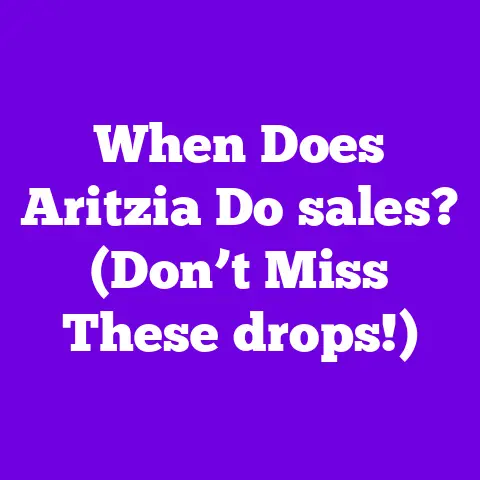When to Put Up Garage sale Signs (Don’t Miss the Rush!)
Hosting a garage sale can feel like orchestrating a well-timed performance.
Just as actors prepare to take the stage, ensuring every prop is in place and every cue is timed perfectly, those of us planning a garage sale must consider the timing, visibility, and preparation involved in attracting an audience.
The goal is clear: maximize foot traffic and sales.
In this article, I will delve into the strategic importance of when to put up garage sale signs, ensuring that you don’t miss the rush of eager bargain hunters ready to scoop up your treasures.
Statistical data often supports these observations.
According to various surveys, nearly 60% of garage sales take place on Saturdays, with the best hours typically falling between 8 AM and 2 PM.
This timeframe allows you to catch both early risers and those who enjoy a leisurely late morning.
Having your signs up well in advance of these peak hours can mean the difference between a bustling sale and a quiet day with minimal visitors.
Section 2: Understanding Your Audience
To maximize the effectiveness of your garage sale signs, it is vital to understand your target audience.
The shoppers who flock to garage sales tend to be bargain hunters, families looking for deals, and collectors on the hunt for unique items.
Knowing who your audience is helps in determining the best timing for your sale.
Local community events, school schedules, and seasonal changes can significantly influence when your audience is out shopping.
For instance, if there’s a local fair or sporting event happening the same weekend as your sale, you may want to adjust your timing to avoid competition.
Additionally, families with children are often busy during the school year, so scheduling your garage sale during school holidays or summer break can attract more visitors.
Section 3: Strategic Sign Placement
Just as a theater production relies on set pieces to enhance the experience, the strategic placement of your garage sale signs is crucial for visibility.
Proper sign placement can draw in potential customers, turning passersby into buyers.
Begin by identifying high-traffic areas near your home, such as busy intersections, community centers, and parks.
Placing signs at these locations can significantly increase the likelihood of attracting attention.
I recommend using bright, bold colors for your signs with clear, easy-to-read lettering.
Ensure that the signs indicate not just that you’re having a garage sale but also the specific address and hours of operation.
Think about how a compelling set design could capture the audience’s eye; in the same way, your signs should be visually appealing.
You can even add arrows directing potential customers to your sale, guiding them through the neighborhood like a well-placed spotlight leading the way.
Section 4: The Countdown to the Sale
As the day of your garage sale approaches, having a countdown timeline can help ensure everything is in order, including the placement of your signs.
I often start my preparations about a week in advance.
Here’s a simple checklist to follow in the week leading up to your sale:
One Week Before:
- Organize Items: Start sorting through your belongings to identify what you want to sell.
Group similar items together to make the setup easier. - Online Promotion: Post about your sale on local community boards, social media groups, and neighborhood apps to generate interest.
Three Days Before:
- Create Signs: Make signs that are large enough to be read from a distance.
Don’t forget to include your address, date, and times. - Scout Locations: Visit potential sign placement locations to ensure they are suitable for visibility.
The Day Before:
- Place Signs: Depending on local regulations, I recommend putting up your signs the evening before the sale.
This way, they are visible early the next morning, capturing the attention of early risers. - Final Setup: Arrange your sale items in your garage or yard to create an inviting display.
The Day of the Sale:
- Put Up Signs Early: On the morning of your sale, make sure to check that all signs are still upright and legible.
If you haven’t already, place some additional signs at critical junctions.
By following this timeline, you ensure that your sale is well-prepared and your signs are strategically placed to draw in customers effectively.
Section 5: Local Regulations and Considerations
As with any performance, there are guidelines to follow, and garage sales are no different.
Many municipalities have regulations regarding signage that you must adhere to.
Before putting up your signs, I recommend checking your local laws to avoid fines or potential removal of your signs.
Some common regulations may include:
– Permit Requirements: Some areas require a permit for garage sales or the placement of signs, especially in public spaces.
– Sign Size and Material: There may be limitations on how large your signs can be or what materials you can use.
Often, signs must be made from cardboard or other non-permanent materials.
– Placement Restrictions: Be mindful of where you place your signs.
Avoid placing them on utility poles, trees, or private property without permission.
Following these guidelines not only keeps you compliant but also fosters goodwill within your community, ensuring that future garage sales are welcomed.
Early signage can create a buzz that attracts more customers throughout the day.
I’ve experienced days when the first few sales were made before I even opened the garage door—thanks to the visibility of my signs!
The excitement generated by early arrivals can turn into a snowball effect, drawing in more and more customers as the morning progresses.
Section 7: Post-Sale Signage and Follow-Up
Once your garage sale concludes, it’s important to address your signs promptly.
Remove them quickly to avoid any fines or to maintain a positive impression in your community.
Leaving signs up can create clutter and may lead to complaints from neighbors.
Additionally, consider how you can leverage the success of one sale to promote future sales.
If you plan to hold garage sales regularly, I recommend taking down your signs but leaving your contact information for potential future customers.
Post about your successes on social media, thanking your buyers and inviting them to the next sale.
This follow-up can build anticipation and establish a loyal customer base for your future endeavors.
Conclusion
In conclusion, the timing of your garage sale signs is as crucial as the performance of a well-rehearsed play.
By understanding the nuances of timing, audience, sign placement, and local regulations, you can maximize your sales and ensure a successful event.
Just as a theater production thrives on meticulous planning and execution, your garage sale will flourish with careful preparation and strategic sign placement.
So, as you prepare for your next garage sale, remember—every great performance begins with a well-timed entrance.
Get those signs up, attract your audience, and enjoy the rush of a successful sale!






